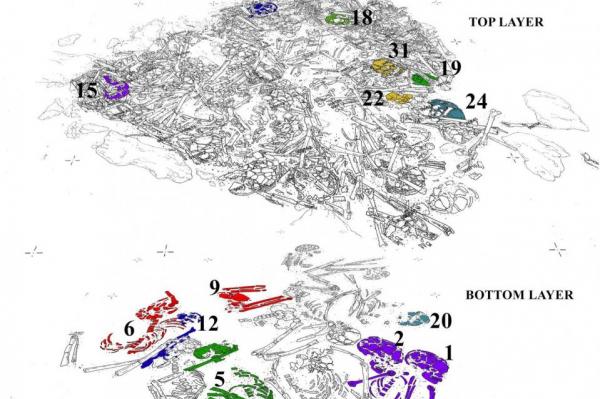- Belgique : mégalithes et cartes postales
- Carnac : une bande dessinée à caractère fantastique
- ECOSSE : Un cercle de pierre daté d'il y a 3500 ans créé de toute pièce par un fermier dans les années 90.
- Estrémadure : La sécheresse révèle une construction mégalithique vieille de 4000 ans.
- Haute-Savoie: Le dolmen de la Pierre aux Fées et le Campaniforme
- Morbihan : Ces Bretons veulent sauver leur menhir de 7 000 ans
- Mégalithisme et philatélie
- Russie : le complexe mégalithique de Vera Island
- Seine-et-Marne : retour sur une découverte mégalithique hors norme à Chamigny
- Un curieux guide des mégalithes
Burgos (Espagne) : la sépulture mégalithique d’Alto de Reinoso
27/01/2016

![]() C’est réellement un modèle d’étude interdisciplinaire d’une sépulture plurielle du Néolithique que Kurt W. Alt, Stephanie Zesch, Rafael Garrido-Pena, Corina Knipper, Anna Szécsényi-Nagy, Christina Roth, Cristina Tejedor-Rodríguez, Petra Held, Íñigo García-Martínez-de-Lagrán, Denise Navitainuck, Héctor Arcusa Magallón et Manuel A. Rojo-Guerra proposent dans la revue Plos One du 20 janvier 2016 PLOS ONE, DOI:10.1371/journal.pone.0146176, sous le titre de « A Community in Life and Death: The Late Neolithic Megalithic Tomb at Alto de Reinoso (Burgos, Spain)
».
C’est réellement un modèle d’étude interdisciplinaire d’une sépulture plurielle du Néolithique que Kurt W. Alt, Stephanie Zesch, Rafael Garrido-Pena, Corina Knipper, Anna Szécsényi-Nagy, Christina Roth, Cristina Tejedor-Rodríguez, Petra Held, Íñigo García-Martínez-de-Lagrán, Denise Navitainuck, Héctor Arcusa Magallón et Manuel A. Rojo-Guerra proposent dans la revue Plos One du 20 janvier 2016 PLOS ONE, DOI:10.1371/journal.pone.0146176, sous le titre de « A Community in Life and Death: The Late Neolithic Megalithic Tomb at Alto de Reinoso (Burgos, Spain)
».
Cette remarquable étude associe les analyses archéologiques, la génétique, l'analyse des isotopes et l’anthropologie physique. Au total, les restes de 47 adultes et adolescents ont été exhumés dans cette sépulture collective qui a été utilisée durant une centaine d’années. Parmi les résultats les plus spectaculaires, il a été démontré que les vestiges les plus anciens, posés sur le fond, sont plus étroitement liés génétiquement ; en outre, les membres d’une même famille sont parfois posés à côté l’un de l’autre, témoignage d’une bonne cohésion sociale.
Les dosages des isotopes du strontium ont montré que seuls quelques-uns des premiers enfants de la communauté ont grandi dans un endroit plus ou moins éloigné d’Alto de Reinoso, tandis que la majorité des restes appartiennent à ceux qui sont nés et ont grandi sur place. Les teneurs en carbone et en azote suggèrent que la communauté se nourrissait principalement de petits ruminants (ovins et caprins) et de céréales, avec accès égalitaire aux récoltes.
On trouvera ci-dessous le résumé anglais de l’article tel que proposé par les auteurs : « The analysis of the human remains from the megalithic tomb at Alto de Reinoso represents the widest integrative study of a Neolithic collective burial in Spain. Combining archaeology, osteology, molecular genetics and stable isotope analysis (87Sr/86Sr, δ15N, δ13C) it provides a wealth of information on the minimum number of individuals, age, sex, body height, pathologies, mitochondrial DNA profiles, kinship relations, mobility, and diet. The grave was in use for approximately one hundred years around 3700 cal BC, thus dating from the Late Neolithic of the Iberian chronology. At the bottom of the collective tomb, six complete and six partial skeletons lay in anatomically correct positions. Above them, further bodies represented a subsequent and different use of the tomb, with almost all of the skeletons exhibiting signs of manipulation such as missing skeletal parts, especially skulls. The megalithic monument comprised at least 47 individuals, including males, females, and subadults, although children aged 0–6 years were underrepresented. The skeletal remains exhibited a moderate number of pathologies, such as degenerative joint diseases, healed fractures, cranial trauma, and a low intensity of caries. The mitochondrial DNA profiles revealed a pattern pointing to a closely related local community with matrilineal kinship patterns. In some cases adjacent individuals in the bottom layer showed familial relationships. According to their strontium isotope ratios, only a few individuals were likely to have spent their early childhood in a different geological environment, whilst the majority of individuals grew up locally. Carbon and nitrogen isotope analysis, which was undertaken to reconstruct the dietary habits, indicated that this was a homogeneous group with egalitarian access to food. Cereals and small ruminants were the principal sources of nutrition. These data fit in well with a lifestyle typical of sedentary farming populations in the Spanish Meseta during this period of the Neolithic ». L’intégralité de l’article est en accès libre sur le site de PlosOne http://www.upi.com/Science_News/2016/01/20/Stone-Age-Spanish-burial-site-reveals-evolving-sense-of-community/6021453323415/
